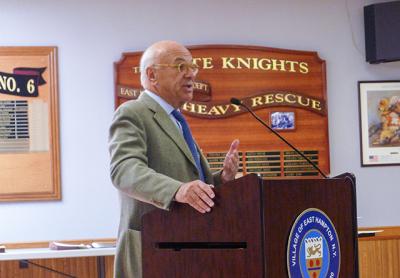Path vs. Patio Redux
Path vs. Patio Redux

An oceanfront property owned by the chief executive officer of the Starbucks coffeehouse chain and his wife, which has been the subject of several applications to the East Hampton Village Zoning Board of Appeals, was once again a topic when that board met on Friday. Although the board was familiar with the application, this time a lawsuit that had been brought by a neighbor was noted.
Howard Schultz, who plans to resign as chief executive officer of Starbucks next month, and his wife, Sheri Kersch Schultz, seek variances and a coastal erosion hazard area permit to allow almost 1,000 square feet more coverage than legally pre-exists and to construct outdoor amenities and relocate a propane tank on their 4.9-acre property at 14 Gracie Lane. Approval would be necessary for a walkway, reflecting pool, garden bench, and a 317-square-foot brick patio within required side-yard setbacks, and the patio also would be seaward of the coastal erosion hazard line.
Leonard Ackerman, an attorney representing the owners, told the board the patio was intended as an amenity for guest rooms in the Schultz house. The nearest neighbor, to the east, has no objection, he said, adding, “I suspect there is no one else that would have any objection to this in terms of impact, noise, lighting, and the like.”
However, Brian Matthews, an attorney representing the owner of adjacent Lily Pond Lane property, told the board that his client has easement rights over a portion of the property and would like to see revised plans before taking a position. “It may be okay; it may not,” he said. “We’d like an opportunity to vet those further.”
Mr. Matthews’s client, who was not named, has a legal right of way to the ocean and took the Schultzes to court arguing that improvements made over the years in that area were detrimental to his access. The court case was decided in the Schultzes’ favor, but the neighbor continues to seek changes in his deeded path.
“I’m not happy,” Mr. Ackerman said, “because, first of all, you’re getting into 10-year-old litigation over someone’s rights, and you shouldn’t be doing that.” Second, he continued, further delay would hinder preparations for a wedding planned on the property in June.
Frank Newbold, the board’s chairman, told Mr. Ackerman that any variance relief should be the minimum necessary. Noting the increase sought in coverage, he asked, “Why couldn’t the terrace be smaller than it is and still accomplish the desired effect?” In response, Ian Hanbach of LaGuardia Design Landscape Architecture, who is charge of the project, said, “I suppose it could be reduced.”
“It seems like this property is getting heavy on the eastern side of it,” said Lys Marigold, the board’s vice chairwoman, “with a new water feature, walkways, and whatever.” Like most oceanfront houses, “it has a big wooden deck, a swimming pool, pavers, and everything else we granted the last time.” She said the board would be granting relief not only to the Schultzes but to future owners of the property.
“It’s about the space that you see within those guest rooms,” Mr. Hanbach said, noting the rooms’ floor-to-ceiling sliding glass doors. “It’s a component of the overall concept.”
Mr. Ackerman then proposed reducing the patio by 128 square feet. Citing the wedding, he asked the board to act expeditiously. “We’re prepared to reduce the coverage. We’re prepared to give you everything you asked for,” he said.
Mr. Newbold, however, said standard procedure “is to see the final plan before we have a final discussion. In that time period, if the neighbor wishes to comment, he’s certainly entitled to comment. But we can’t just give you parameters today and close the hearing.” Mr. Ackerman and Mr. Hanbach agreed to revise the landscape plan showing a smaller guest patio farther from the side property line. The hearing will continue at the board’s next meeting, on Friday, March 10.
In one board decision announced at the meeting, Pierre Casimir-Lambert was granted a wetlands permit to allow removal of phragmites at 15 Chauncey Close. His 3.8-acre property is on Georgica Cove, and the phragmites is part of a bottleneck that restricts water flow between the cove and the rest of the pond. It is also within a portion of a scenic easement granted to the village in 1978. Plans include hand-cutting the invasive reed over several years, as well as vegetating two areas within the scenic easement that had been cleared.




